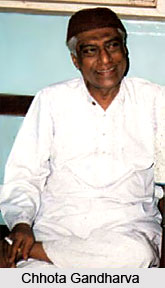 Chhota Gandharva was born on 1918 whose popular name was Saudagar Nagnath Gore. He was a great artist of Sangitnatak and also Marathi theatre. Born in the small village of Bhadali near Koregaon in Satara district, he gave up school after just two years and joined Damuanna Joshi`s Balmohan Natak Mandali. His first appearance was in 1928 in Pune. He used to act female characters, and his mentor Joshi first called him Chhota i.e. `small` Gandharva, after the legendary `Bal Gandharva. At Balmohan he learnt Hindustani vocal music from Dattubuwa Bagalkotkar and, later, from Narharbuwa Patankar, Sawai Gandharva, Bhurji Khan, and other singers of the Jaipur and Gwalior gharanas. When his voice broke, he stopped doing women`s roles for some time, but returned to them till 1934. His first major part as a hero was in Atre`s Gharabaher i.e. `Outside the House` in 1934, followed by Udyacha sansar i.e. `Our Future Life` in 1936 and Lagnachi bedi or `Marriage Chains` in 1936.
Chhota Gandharva was born on 1918 whose popular name was Saudagar Nagnath Gore. He was a great artist of Sangitnatak and also Marathi theatre. Born in the small village of Bhadali near Koregaon in Satara district, he gave up school after just two years and joined Damuanna Joshi`s Balmohan Natak Mandali. His first appearance was in 1928 in Pune. He used to act female characters, and his mentor Joshi first called him Chhota i.e. `small` Gandharva, after the legendary `Bal Gandharva. At Balmohan he learnt Hindustani vocal music from Dattubuwa Bagalkotkar and, later, from Narharbuwa Patankar, Sawai Gandharva, Bhurji Khan, and other singers of the Jaipur and Gwalior gharanas. When his voice broke, he stopped doing women`s roles for some time, but returned to them till 1934. His first major part as a hero was in Atre`s Gharabaher i.e. `Outside the House` in 1934, followed by Udyacha sansar i.e. `Our Future Life` in 1936 and Lagnachi bedi or `Marriage Chains` in 1936.
He left Balmohan in 1943 and established his own Kala Vikas Company along with a few friends, but it did not last long and he joined Bharat Natya Kala. His acting, especially in revivals of Kirloskar`s Saubhadra, Khadilkar`s Manapaman, and Deval`s Samshaykallol, grew very popular because of his sweet singing and he continued to perform in them for twenty-five years. Over a career spanning more than fifty years, he sang and composed for a large number of new plays, too. Columbia Gramophone Company brought out his first recording in 1933, succeeded by innumerable discs. His voice was characterized by a rare soft and delicate texture, and his style by a huge variety of mind i.e. `meend`, or glissando, murki or ornamentation, and tan i.e. fast embellished runs. He created more than 100 bandish or compositions as well. This legendary artist died in 1997.




















